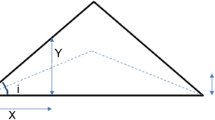Abstract
Shear behaviour of rock joints can be studied under both constant normal load (CNL) and constant normal stiffness (CNS) boundary condition. CNS condition is suitable for non planar and reinforced rock joints whereas CNL condition is suitable for planar and non reinforced rock joints. In the present study shear behaviour of modelled rock joints with different asperity have been experimentally investigated under both CNL and CNS boundary conditions. Test results indicate that CNS boundary conditions gives higher shear strength as compare to CNL boundary condition when other parameter of testing is kept same. But, this effect tends to diminishes with increase in normal stress on the shearing plane and at high normal stress both CNL and CNS boundary conditions gives same shear strength. A new shear strength model is proposed for both the boundary condition and the proposed model is validated by comparing the predicted shear strength with present experimental results and results available in the literature for natural and artificial rock joints with different asperity and roughness. The new study and model will be useful for safe and economical design of underground openings in jointed rocks, stability analysis of rock slopes, design of foundation on rock and design of rock socketed piles.




















Similar content being viewed by others
References
Asadollahi P, Tonon F (2010) Constitutive model for rock fractures: revisiting Barton’s empirical model. Eng Geol 113:11–32
Barton N (1973) Review of a new shear strength criterion for rock joints. Eng Geol 7:287–332
Byerlee JD (1975) The fracture strength and frictional strength of weber sandstone. Int J Rock Mech Min Sci Geomech Abst 12:1–4
Deere DU, Miller RP (1966) Engineering classification and index properties of rock. Technical report no. AFNL-TR-65-116. Air Force Weapons Laboratory, Albuquerque
Desai CS, Fishman KL (1991) Plasticity-based constitutive model with associated testing for joints. Int J Rock Mech Min Sci Geomech Abst 28:15–26
Ghazvinian AH, Taghichian A, Hashemi M, Mar’ashi SA (2010) The shear behaviour of bedding planes of weakness between two different rock types with high strength difference. Rock Mech Rock Eng 43:69–87
Goldestin M, Gooser B, Pyrogovsky N, Tulinov R, Turovskaya A (1966) Investigation of mechanical properties of cracked rock, vol 1. In: Proceedings of the 1st congress international society in rock mechanics, Lisbon, pp 521–524
Grasselli G, Egger P (2003) Constitutive law for the shear strength of rock joints based on three-dimensional surface parameters. Int J Rock Mech Min Sci Geomech 40:25–40
Indraratna B, Haque A, Aziz N (1998) Laboratory modelling of shear behaviour of soft joints under constant normal stiffness condition. J Geotech Geol Eng 16:17–44
ISRM (1977) Suggested method for determining water content, porosity, density, absorption and related properties and swelling and slake-durability index properties. Pergamon Press
ISRM (1979) Suggested method for determining the uniaxial compressive strength and deformability of rock materials. Pergamon Press
Jeong S, Ahn S, Seol H (2010) Shear load transfer characteristics of drilled shafts socketed in rocks. Rock Mech Rock Eng 43:41–54
Jiang Y, Xiao J, Tanabashi Y, Mizokami T (2004) Development of an automated servo-controlled direct shear apparatus applying a constant normal stiffness condition. Int J Rock Mech Min Sci 41:275–286
Kim DY, Chun BS, Yang JS (2006) Development of a direct shear apparatus with rock joints and its verification tests. Geotech Test J 29(5):1–9
Ladanyi B, Archambault G (1970) Simulation of shear behaviour of a jointed rock mass. In: Proceedings of 11th symposium on rock mechanics: theory and practice. American Institute of Mining, Metallurgical and Petroleum Engineers, New York, pp 105–125
Maksimovic M (1996) The shear strength components of a rough rock joint. Int J Rock Mech Min Sci Geomech Abst 33:769–783
Newland PL, Allely BH (1957) Volume changes in drained triaxial tests on granular materials. Geotechnique 7:17–34
Obert L, Brady BT, Schmechel FW (1976) The effect of normal stiffness on the shear resistance of rock. Rock Mech 8(2):57–72
Ooi LH, Carter PJ (1987) A constant normal stiffness direct shear device for static and cyclic loading. Geotech Test J 10(1):3–12
Patton FD (1966) Multiple modes of shear failure in rock and related materials. Dissertation, University of Illinois, Urbana
Rao KS, Shrivastava AK, Singh J (2009) Development of an automated large scale direct shear testing machine for rock. In: Indian geotechnical conference, pp 238–244
Saiang D, Malmgren L, Nordlund E (2005) Laboratory tests on shortcrete rock joints in direct shear, tension and compression. Rock Mech Rock Eng 38:275–297
Seidel JP, Haberfield CM (2002) A theoretical model for rock joints subjected to constant normal stiffness direct shear. Int J Rock Mech Min Sci Geomech Abst 39:539–553
Shrivastava AK (2012) Physical and numerical modelling of shear behaviour of jointed rocks under CNL and CNS boundary conditions. Dissertation, IIT Delhi
Shrivastava AK, Rao KS (2010) Effect of boundary conditions on shear behaviour of rock joint. In: ISRM international symposium and 6th Asian rock mechanics symposium—advances in rock engineering, New Delhi, India
Shrivastava AK, Rao KS (2011) Shear behaviour of non planar rock joint. In: 14th Asian regional conference on soil mechanics and geotechnical engineering, Hong Kong
Shrivastava AK, Rao KS (2013) Development of a large-scale direct shear testing machine for unfilled and infilled rock joints under constant normal stiffness conditions. Geotech Test J 36(5):670–679
Shrivastava AK, Rao KS, Rathod GW (2011) Shear behaviour of rock under different normal stiffness. In: 12th international congress on rock mechanics (ISRM), Beijing, pp 831–835
Withers JH (1964) Sliding resistance along discontinuities in rock mass. Dissertation, University of Illinois
Xie H, Pariseau WG (1992) Fractal estimate of joint roughness coefficients. In: Proceedings of the international conference on fractal and jointed rock masses, Lake Tahoe, CA, pp 125–131
Yang ZY, Chiang DY (2000) An experimental study on the progressive shear behaviour of rock joints with tooth-shaped asperities. Int J Rock Mech Min Sci 37:1247–1259
Author information
Authors and Affiliations
Corresponding author
Rights and permissions
About this article
Cite this article
Shrivastava, A.K., Rao, K.S. Shear Behaviour of Rock Joints Under CNL and CNS Boundary Conditions. Geotech Geol Eng 33, 1205–1220 (2015). https://doi.org/10.1007/s10706-015-9896-2
Received:
Accepted:
Published:
Issue Date:
DOI: https://doi.org/10.1007/s10706-015-9896-2




